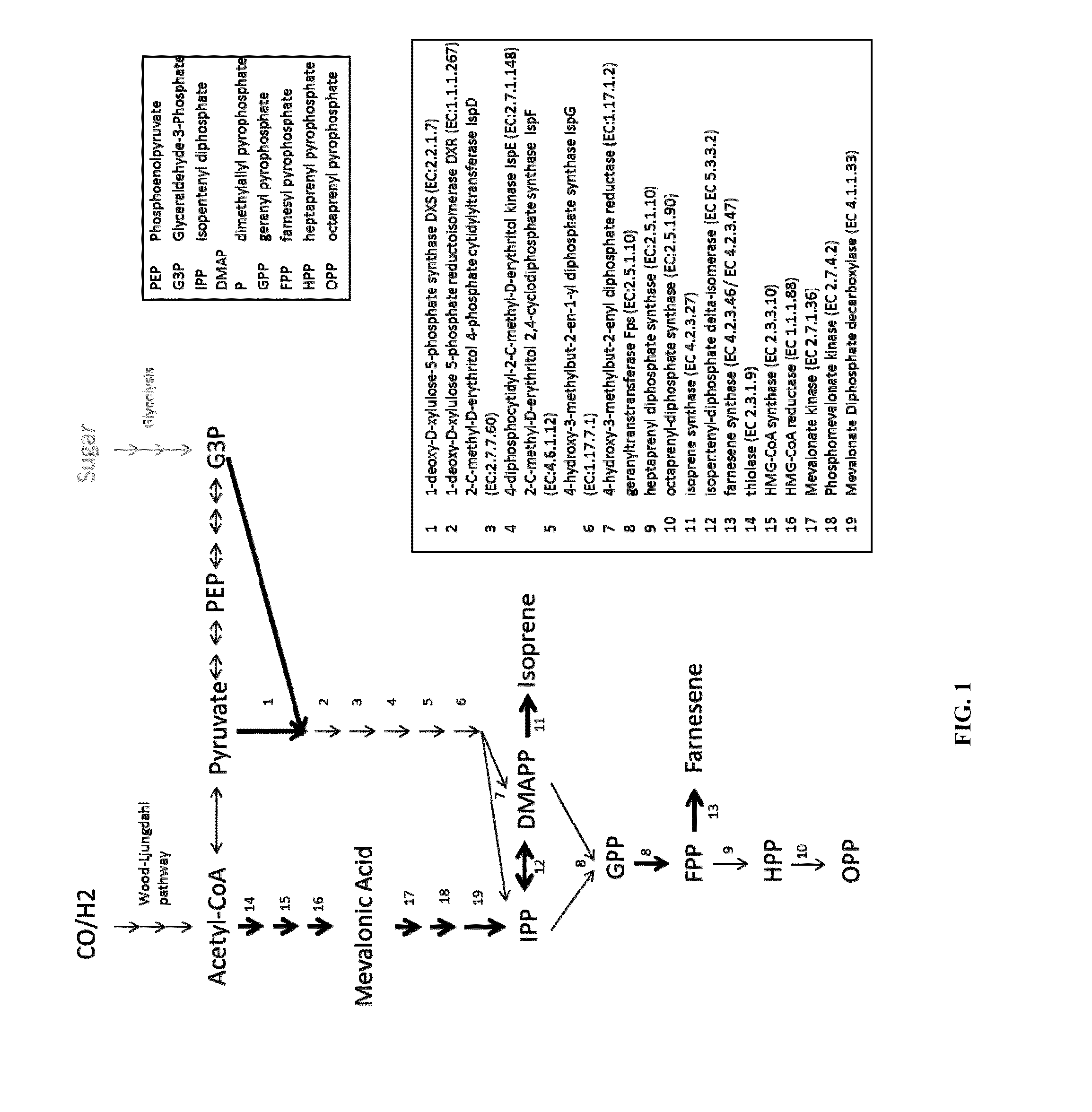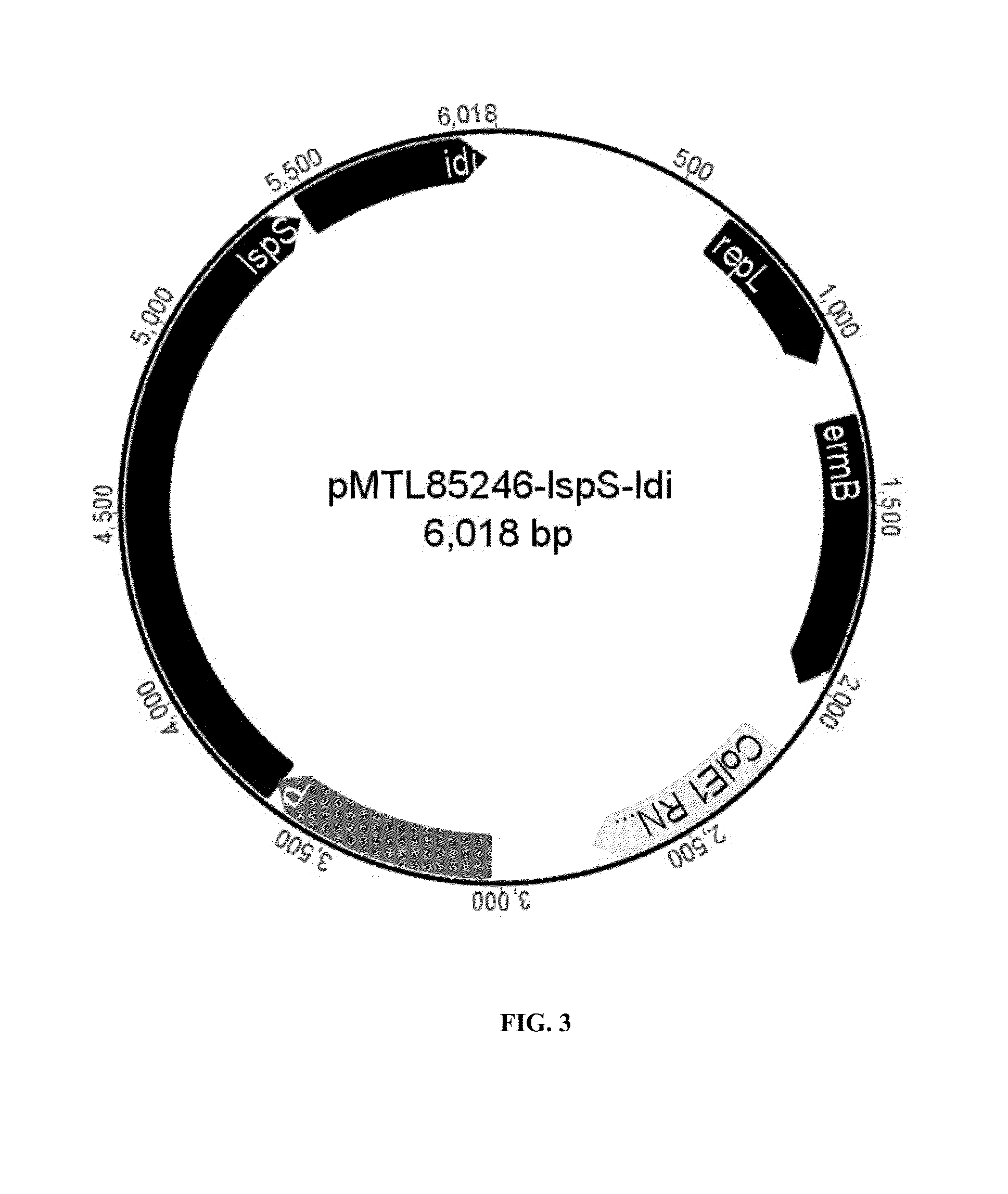Recombinant microorganisms and uses therefor
a technology of recombinant microorganisms and recombinant proteins, which is applied in the direction of transferases, carbon-carbon lyases, lyases, etc., can solve the problems that most bacteria are not known to produce terpenes, and not all bacteria comprise the necessary cellular machinery to produce terpenes and/or their precursors, etc., and achieves the effect of increasing the number of copies
- Summary
- Abstract
- Description
- Claims
- Application Information
AI Technical Summary
Benefits of technology
Problems solved by technology
Method used
Image
Examples
example 1
Expression of Isoprene Synthase in C. autoethanogenum for Production of Isoprene from CO
[0365]The inventors have identified terpene biosynthesis genes in carboxydotrophic acetogens such as C. autoethanogenum and C. ljungdahlii. A recombinant organism was engineered to produce isoprene. Isoprene is naturally emitted by some plant such as poplar to protect its leave from UV radiation. Isoprene synthase (EC 4.2.3.27) gene of Poplar was codon optimized and introduced into a carboxydotrophic acetogen C. autoethanogenum to produce isoprene from CO. The enzyme takes key intermediate DMAPP (Dimethylallyl diphosphate) of terpenoid biosynthesis to isoprene in an irreversible reaction (FIG. 1).
Strains and Growth Conditions:
[0366]All subcloning steps were performed in E. coli using standard strains and growth conditions as described earlier (Sambrook et al, Molecular Cloning: A laboratory Manual, Cold Spring Harbour Labrotary Press, Cold Spring Harbour, 1989; Ausubel et al, Current protocols in...
example 2
Expression of Isopentenyl-Diphosphate Delta-Isomerase to Convert Between Key Terpene Precursors DMAPP (Dimethylallyl Diphosphate) and IPP (Isopentenyl Diphosphate)
[0381]Availability and balance of precursors DMAPP (Dimethylallyl diphosphate) and IPP (Isopentenyl diphosphate) is crucial for production of terpenes. While the DXS pathway synthesizes both IPP and DMAPP equally, in the mevalonate pathway the only product is IPP. Production of isoprene requires only the precursor DMAPP to be present in conjunction with an isoprene synthase, while for production of higher terpenes and terpenoids, it is required to have equal amounts of IPP and DMAPP available to produce Geranyl-PP by a geranyltransferase.
Construction of Isopentenyl-Diphosphate Delta-Isomerase Expression Plasmid:
[0382]An Isopentenyl-diphosphate delta-isomerase gene idi from C. beijerinckii (Gene ID:5294264), encoding an Isopentenyl-diphosphate delta-isomerase (YP—001310174.1), was cloned downstream of ispS. The gene was amp...
example 3
Overexpression of DXS Pathway
[0385]To improve flow through the DXS pathway, genes of the pathway were overexpressed. The initial step of the pathway, converting pyruvate and D-glyceraldehyde-3-phosphate (G3P) into deoxyxylulose 5-phosphate (DXP / DXPS / DOXP), is catalyzed by an deoxyxylulose 5-phosphate synthase (DXS).
Construction of DXS Overexpression Expression Plasmid:
[0386]The dxs gene of C. autoethanogenum was amplified from genomic DNA with oligonucleotides Dxs-SalI-F (SEQ ID NO: 29: GCAGTCGACTTTATTAAAGGGATAGATAA) and Dxs-XhoI-R (SEQ ID NO: 30: TGCTCGAGTTAAAATATATGACTTACCTCTG) as described for other genes above. The amplified gene was then cloned into plasmid pMTL85246-ispS-idi with SalI and XhoI to produce plasmid pMTL85246-ispS-idi-dxs (SEQ ID NO: 31 and FIG. 4). DNA sequencing using oligonucleotides given in Table 3 confirmed successful cloning of ispS, idi, and dxs without mutations (FIG. 5). The ispS and idi genes are as described in example 1 and 2 respectively.
TABLE 3Oligo...
PUM
| Property | Measurement | Unit |
|---|---|---|
| temperature | aaaaa | aaaaa |
| pressure | aaaaa | aaaaa |
| pressure | aaaaa | aaaaa |
Abstract
Description
Claims
Application Information
 Login to View More
Login to View More - R&D
- Intellectual Property
- Life Sciences
- Materials
- Tech Scout
- Unparalleled Data Quality
- Higher Quality Content
- 60% Fewer Hallucinations
Browse by: Latest US Patents, China's latest patents, Technical Efficacy Thesaurus, Application Domain, Technology Topic, Popular Technical Reports.
© 2025 PatSnap. All rights reserved.Legal|Privacy policy|Modern Slavery Act Transparency Statement|Sitemap|About US| Contact US: help@patsnap.com



